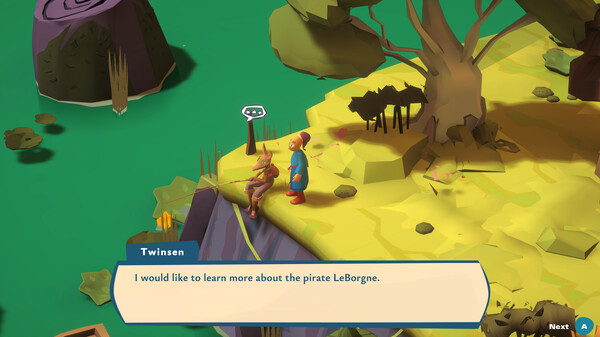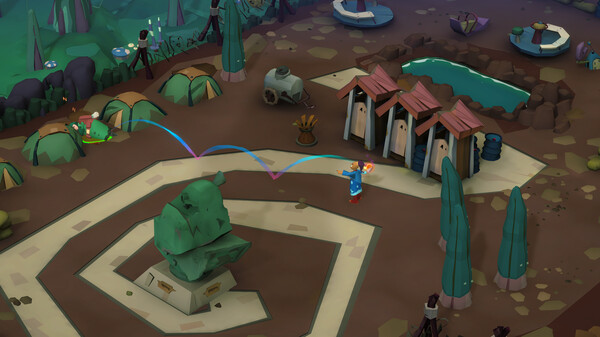My initial contact with the LBA franchise was in 1998, when I bought Twinsen's Odyssey from a newsstand. It was the first Zelda-like adventure game that I had ever played and it turned out to be fundamental in shaping my appreciation for the genre as a whole. Twinsen's world quickly became one of my favorites for all of its zany characters and endearing charm. I never got to play its predecessor as a child, though — hell, I didn't even know that there was a prequel to Odyssey in the first place. Only when I grew up to my teenage years did I find out about its existence. After playing it, I realised it wasn't as entertaining as the second, but I still enjoyed the experience. I've waited many years to play another one of these games, so you can imagine my enthusiasm when Twinsen's Quest finally came to be. But is it a worthy remake? Let's see. LBA's plot is a straightforward tale of rebels resisting a tyrannical government. The game's world of Twinsun is divided in two hemispheres that are separated by an icy mountain range and bathed in constant sunlight by two suns. The planet is home to four main species of sentient creatures, which resemble human beings, rabbits, elephants and spherical humanoids. The megalomaniacal Doctor Funfrock rises to power and imposes a global dictatorship, creating clones and monsters that enforce his will upon the population. He seeks to harness the power of the Sendells, a race of magical beings who reside within the planet and protect it from harm. Twinsen is the heroic protagonist, who discovers his father's past as a wizard of the Sendells and utilises the powers passed on through his lineage to fight back against the tyrant. The main alterations made to the original plot were the inclusion of Luna, Twinsen's sister, who motivates him to save her from kidnapping, and the fact that Zóe, his love interest, assumes a more active role in the resistance movement. It's a story suited for children, honestly, and it's still as charming as it was back in the day, in my opinion. One of the most iconic elements of the original games was their sound design. I'm not exactly an expert on audio engineering, but I liked the work done by 2.21 here. Everything sounds good enough, despite the occasional glitches — more on this later. You can even hear some of the classic effects in this remake, like Twinsen's jumping sound and the peculiar bubbly throw of his magic ball. The voice acting is also pretty well done, with Twinsen sounding much like he did in Odyssey and Funfrock coming off as a crazy prick. People complained about Luna's childish demeanor, but I didn't mind her presence in the story — she's young and I suspect she'll have greater development in a potential sequel. I also think the soundtrack deserves proper applause, given that the catchy songs I liked so much at the time were gracefully rearranged. The first big and obvious change we see in this remake, however, is the new visual style, which confers a more colorful and detailed appearance to the game's environments and characters. I've always considered the original's graphics to be rather drab and dull looking, so I quite liked this fresh coat of paint. Granted, there was some criticism thrown at it, particularly regarding the design of certain objects. I can agree that sometimes, depending on the camera angle, things may look rather odd or confusing, but overall I think this art style contributed to a nice reimagining of the story. Some folks complained that the vivid colors erased the aspect of decay inflicted on the world by Funfrock's regime, but I could still see signs of degradation in the streets and buildings of Twinsun. My only real gripe in this department is the frequent occurrence of visual glitches. Like its past iteration, Twinsen's Quest is an isometric action-adventure game not dissimilar from Legend of Zelda: A Link to the Past. Twinsen gets to explore different towns and islands, talk to NPCs and collect quest items to complete missions. He is also able to acquire money to purchase a limited amount of stuff, but there is no character customisation or build variance. Players fight monsters with melee attacks and with the signature projectile weapon mentioned earlier, the magic ball. Combat is pretty simplistic and sometimes cumbersome, and it is often advisable to simply avoid confrontations altogether because dodging enemy attacks is a bit unreliable. There aren't any character stats or level ups, but the magic ball is upgraded three times over the course of the campaign, allowing Twinsen to face stronger opponents. While the levels, quests and foes created for the original title remained basically the same, the remake did change the mechanics of gameplay in a significant manner. Now, two major things were reworked. The first one is the movement system, which became much more streamlined. Back in the original, there were four stances that defined how Twinsen would move himself, requiring players to constantly switch between these stances in order to walk, run, fight or sneak around. This posture framework was entirely replaced with a fluid system of walking, running and punching, while sneaking was completely phased out. This caused some controversy, but I never really considered sneaking to be of much importance before. Also gone are the tank controls, by the way — Twinsen now moves in the direction of the pressed key — and I liked this adaptation. Finally, the second big change was the subtraction of the game's mana bar, which determined if the magic ball would bounce on surfaces. With magic points removed, the ball always bounces now. This made the remake a bit easier, I'd say. Unfortunately, I came across numerous flaws during my playthroughs. None of them really prevented me from finishing the game and unlocking its achievements, but they were disappointing and indicative that this project could have spent more time in the oven. The first category of problems comprises the visual and audio glitches. I mentioned them quickly earlier: explosions fail to appear when enemies perish, the magic ball gets stuck in the environment, NPCs fail to vocalize their lines, subtitles do not display what the characters are really saying, and so forth. I also include here the shoddy quality of certain animations, or the complete absence of them. Twinsen seems to be rather stiff and awkward in his movements, and there are no animations for embarking on and disembarking from vehicles and boats. These particular issues, of course, aren't game breaking, but then we have the second category: combat flaws. Despite the fact that the controls were overhauled, I still found Twinsen to be rather sluggish, and this made him more vulnerable. His dodging maneuver takes some time to be executed and frequently fails to save him from projectiles. The new aiming system for the magic ball can be unreliable depending on the topography of the level. Many times I struggled to throw it in the correct direction when Twinsen was in an elevated position. The AI of enemies sometimes simply stopped functioning, which made them non reactive to my attacks. I also felt that the lock-on mechanism constantly disengaged from my targets if I moved just a bit away from them — not to mention that dodging while locked on simply doesn't work adequately. These problems are quite annoying and require correction, but aren't as severe as the ladders that catapult Twinsen outside of the level, or the statue in the Temple of Bú that got stuck on top of a pillar, forcing me to reload a previous save. So, yes, although this remake could be more polished, I still think it's a worthwhile experience. I consider it a fun introduction to the franchise because its merits outweigh its flaws. Hopefully the developers learned some valuable lessons with this project and will use them to create a more robust reimagining of the second game. I'll be looking forward to it.
Expand the review
























